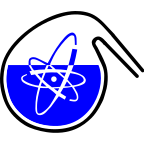Speaker
Description
In order to develop resins with selectivity to U(VI) in HNO3 media, we have synthesized several polymer beads with the structure of a monoamide as the functional group. For wider applications of these resins including treatment of highly-radioactive solutions, it is necessary to investigate their stability under irradiation conditions. In this study, resins with a chain-type monoamide and a cyclic-type one as the functional group were irradiated by γ-ray in HNO3 and adsorptivities to FP ions were examined. The structure change in the resins by irradiation was also studied.
N-methyl-N-vinylacetamide (VMAA) [1] was used the chain-type monoamide resin. For the cyclic type resin, that with a 6-membered ring of 1-(4-vinylbenzyl)piperidin-2-one (VBPP) was newly synthesized. The resins and HNO3 of up to 6 M were mixed in a Pyrex sample tube at a ratio of 5 cm3/g, respectively, and used as the samples for γ-ray irradiation. Irradiation by the Co-60 source was performed up to 0.95 MGy at room temperature under ambient atmosphere. The irradiated resins were separated from the supernatant and washed using distilled water to avoid further degradation of the resins by HNO3. Adsorptivities of the irradiated resins to FP ions were examined in HNO3 by the batch method similarly to the previous studies[1-3]. The resulting resins and the supernatants were also analyzed by IR and NMR, respectively.
For irradiated VMAA, the Kd values for Pd(II) and Re(VII) were found to become lower than those of the neat ones. This indicate that the degradation properties are similar to those of chain-type monoamide extractants[4]. On the other hand, the Kd values of the irradiated VBPP for Pd(II) and Zr(IV) were found to be increased at lower concentration of HNO3 with increasing dose. Polyvinylpolypyrrolidone (PVPP), which is a cyclic monoamide resin and has a 5-membered pyrrolidone ring, changes the chemical structure by γ-ray irradiation in HNO3, where the degradation starts with the ring opening and the final products have been found to be a primary-amine-type anion exchange resin and oxalic acid[5]. This study suggests that the major route of change in the chemical structure of VBPP is basically identical to that of PVPP and that the resulting resin structures differ according to the number of carbon atoms in the cyclic monoamides.
[1] M. Nogami et al., J. Radioanal. Nucl. Chem. 273 (2007) 37.
[2] M. Nogami et al., J. Radioanal. Nucl. Chem. 284 (2010) 195.
[3] M. Nogami et al., Prog. Nucl. Energy, 284 (2008) 462.
[4] P. B. Ruikar et al., J. Radioanal. Nucl. Chem. Letters 176 (1993) 103.
[5] M. Nogami et al., J. Radioanal. Nucl. Chem. 296 (2013) 423.

